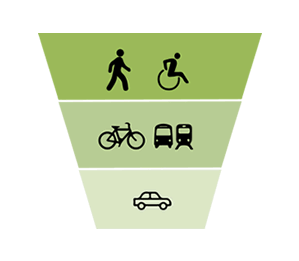Complete Streets: Plan, design, build, maintain, and operate the city’s transportation system in a way that prioritizes pedestrians first, followed by bicycling and transit use, and lastly motor vehicle use. (Complete Streets Policy. Adopted May 2016.)

The City’s Complete Street Policy creates a modal hierarchy in the public right of way. The Policy prioritizes walking and pedestrians first, followed by bicycling and taking transit, and lastly driving motor vehicles. This policy framework guides all transportation-related decisions and encompasses all elements in the public right of way. The Complete Streets Policy vision is to improve the environment, the health and safety of residents, and support and strengthen the local economy.
 ACTION STEPS
ACTION STEPS
The City will seek to accomplish the following action steps to plan, design, build, maintain, and operate the city’s transportation system in a way that prioritizes pedestrians first, followed by bicycling and transit use, and lastly motor vehicle use. (Complete Streets Policy. Adopted May 2016.)
- Implement the Complete Streets Policy throughout all phases of transportation projects and initiatives, including programming, planning, design, construction, operation, and maintenance.
- Incorporate the Complete Streets Policy into all elements of the public right-of-way, including landscaping, transit shelters, lighting, signs, traffic lights, parking meters, bicycle parking, and furniture.
- Document the implementation of the Complete Streets Policy for each individual project.
- Prioritize projects that will improve the pedestrian, bicycle, and transit networks when developing the City’s long-range Capital Improvement Program, focusing on an equitable distribution of resources and recognizing historical practices that led to inequitable pedestrian networks.
- Incorporate a context-based approach informed by the Complete Streets Policy when planning and designing transportation projects.
- Continue to explore flexible and innovative designs that aim to achieve desired outcomes, and continue to evaluate the latest design standards and innovative concepts, seeking guidance from established best practices.
- Where standards established by other units of government conflict with the City’s Complete Streets Policy, seek design exceptions and variances to their establish standards.
- Develop strong curbside management policies to take full advantage of a dynamic urban environment.

